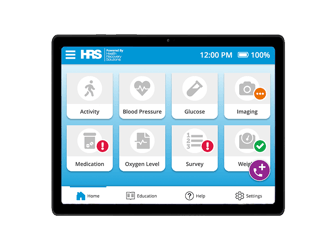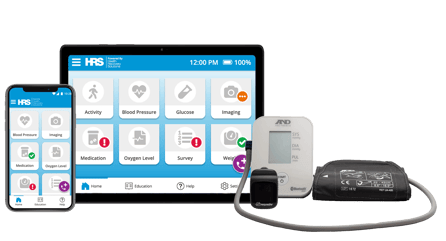Recently diagnosed with congestive heart failure (CHF), Rebecca has been admitted to the hospital several times over the last six months. One monring, Rebecca arrives at her local hospital’s emergency department, experiencing difficulty breathing.
Inpatient Virtual Care Playbook
Reduce workload for floor RNs while increasing patient communication, education, and self-symptom management
What is the Inpatient Virtual Care Playbook?
Reduce Clinician Workload and Improve Nurse Retention
Support floor RNs—and allow RNs to focus on the most high-acuity patients—by appointing a dedicated virtual nurse responsible for monitoring patient symptoms and vital signs, providing condition and medication education, and leading patient communication.
Increase Patient Assessments and Touchpoints
Continuously monitor patient symptoms and vital signs to ensure all exacerbations are identified, triaged, and addressed—just in time, every time.
Expand Access to Specialty Care Providers
Leverage virtual visits to provide patients with access to specialty care providers, including registered dietitians and social workers
Expand Your Digital Strategy and Telehealth Footprint into the Inpatient Setting
Leverage RPM and video calls to augment care delivery for patients that require hospital stay.
Build Long Term Patient Engagement
Provide condition-specific educational content and teach-back quizzes to engage patients in their care plan and increase their understanding of their condition and care needs—increasing overall quality of life.
Create Cost Savings
Increase cost savings by reducing length of stay, decreasing use of PPE and medical supplies, maximizing bed capacity, and increasing nurse productivity. Inpatient virtual care programs can also create new revenue as a value-based care program achieving the triple aim.
Download the Inpatient Virtual Care Playbook
Inpatient Virtual Care in Action
Upon admission to the hospital, Rebecca is introduced to the Inpatient Virtual Care program by the floor’s Telehealth Technician who explains the features and benefits of the program, including the ability for Rebecca to contact the Dedicated Virtual Nurse whenever necessary.
On day two of her hospital stay, the Inpatient Virtual Nurse contacts Rebecca via the HRS tablet and begins to educate Rebecca on the medications she received that morning along with information on her disease process.
During this virtual visit Rebecca notifies the virtual nurse that she was getting a slight headache. The virtual nurse asked her several questions to assess her pain and contacted the floor nurse to deliver the as-needed Tylenol that was ordered.
Over the next few days, the Dedicated Virtual Nurse continues to perform a virtual visit with Rebecca each day, reviewing her symptoms, medication regimens, and preparing her for discharge.
Using HRS’ CaregiverConnect app, Rebecca’s daughter is able to join the virtual visits and keep up to date on her mother’s condition and care plan.
Prior to discharge, the Dedicated Virtual Nurse reviews Rebecca’s discharge instructions and schedules any follow-up visits, allowing Rebecca to recover at home with her daughter while feeling safe and prepared.


